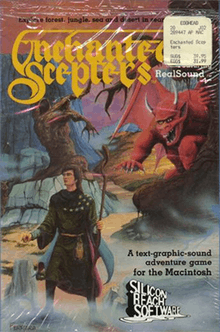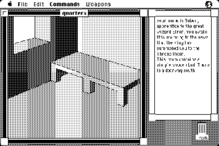Enchanted Scepters
Enchanted Scepters is a point-and-click adventure game, released in 1986[1][2] (with a 1984 copyright date on the box and floppy label).
| Enchanted Scepters | |
|---|---|
 | |
| Developer(s) | Silicon Beach Software |
| Engine | World Builder |
| Platform(s) | Macintosh |
| Release | 1984 |
| Genre(s) | Adventure |
| Mode(s) | Single-player |

The player must find the four fire, earth, air and water scepters hidden across the Kingdom, and return them to the Wizard. The gameplay is much like a text adventure game; the screen shows a picture of the room the player is currently in and to the right is a description of the room. The description mentions any items that can be used or picked up, but to do that the player must click on the item in the picture. The pictures change as the player moves to a new scene. There is no movement in the picture, but enemies are inserted when encountered, accompanied by sound effects. The player can then choose from a drop down menu whether to flee, and which way (north, south, east or west and occasionally up or down), or to fight, and with which weapon.
Enchanted Scepters was created with the World Builder adventure authoring system which was later released to consumers in 1986.
Legacy
Perhaps due to confusion resulting from the back-dated copyright year on the box and disk label, Enchanted Scepters has been incorrectly reported as being the first Macintosh game released that used digitized sound—this was actually Silicon Beach Software's earlier release, "Airborne!"[3] It has also been incorrectly described as the first adventure game to use a point-and-click interface, but in that regard it was preceded by (at least) Déjà Vu from ICOM Simulations, released in 1985.[4]
In 1990, a fangame titled Lost Crystal was released that was also developed using the World Builder engine and that took up the plot of Enchanted Scepters.
References
- "MacUser". May 1986. Cite magazine requires
|magazine=(help)https://archive.org/stream/MacUser8605May1986/MacUser_8605_May_1986_djvu.txt - "MacWorld". June 1986. Cite magazine requires
|magazine=(help)https://archive.org/stream/MacWorld_8606_June_1986/MacWorld_8606_June_1986_djvu.txt - "MacWorld". April 1986. p. 118. Cite magazine requires
|magazine=(help)https://archive.org/details/MacWorld_8604_April_1986/mode/2up - https://macintoshgarden.org/games/deja-vu